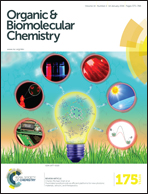A concentration dependent auto-relay-recognition by the same analyte: a dual fluorescence switch-on by hydrogen sulfide via Michael addition followed by reduction and staining for bio-activity†
Abstract
H2S is shown, for the first time, to play an extraordinary dual role due to its nucleophilicity and reducing property with our single chemosensor, PND [4-(piperidin-1-yl) naphthalene-1,2-dione]. The initial nucleophilic attack via Michael addition (a lower concentration of H2S, blue fluorescence) is followed by the reduction of the 1,2-diketo functionality (a higher concentration of H2S, green fluorescence). This chemosensor, which also shows biological response, is remarkably effective in sensing the same analyte (H2S) at its different concentrations in a relay pathway via a fluorescence “off–on–on” mechanism, and this is also supported by DFT calculation and Cyclic voltammograms.


 Please wait while we load your content...
Please wait while we load your content...